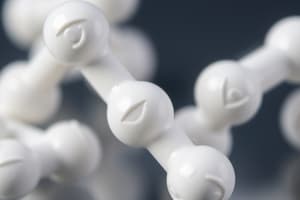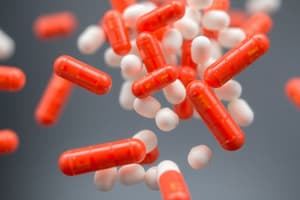Podcast
Questions and Answers
How does clindamycin block peptide bond formation?
How does clindamycin block peptide bond formation?
- By interfering with DNA gyrase activity
- By binding to the 50S ribosomal subunit (correct)
- By disrupting the integrity of the bacterial cell wall
- By inhibiting the synthesis of tRNA
A patient presents with a suspected anaerobic infection above the diaphragm. Which of the following antibiotics would be LEAST appropriate to administer, considering spectrum of activity?
A patient presents with a suspected anaerobic infection above the diaphragm. Which of the following antibiotics would be LEAST appropriate to administer, considering spectrum of activity?
- Clindamycin
- Penicillin
- Amoxicillin-clavulanate
- Metronidazole (correct)
What is the most common mechanism of bacterial resistance to clindamycin?
What is the most common mechanism of bacterial resistance to clindamycin?
- Mutation in the gene encoding DNA gyrase
- Increased expression of efflux pumps
- Enzymatic degradation of the antibiotic
- Methylation at the ribosome binding site (correct)
A patient develops severe diarrhea after a course of clindamycin. Which of the following conditions is the MOST likely cause?
A patient develops severe diarrhea after a course of clindamycin. Which of the following conditions is the MOST likely cause?
Which of the following pathogens is LEAST likely to be effectively treated by clindamycin?
Which of the following pathogens is LEAST likely to be effectively treated by clindamycin?
Flashcards
Clindamycin mechanism
Clindamycin mechanism
Lincosamide antibiotic that inhibits peptide bond formation, leading to bacteriostatic effects.
Clindamycin's spectrum of activity
Clindamycin's spectrum of activity
Community-acquired MRSA, Staph epi, Strep pneumoniae, Anaerobic infections (Bacteroides, Clostridium perfringens). Good for anaerobic infections above the diaphragm.
Clindamycin resistance
Clindamycin resistance
Resistance to clindamycin arises from methylation at the ribosome binding site.
Major side effect of Clindamycin
Major side effect of Clindamycin
Signup and view all the flashcards
Study Notes
- Lincosamides are a class of antibiotics, with clindamycin being a specific example.
- They function by inhibiting peptide bond formation, which makes them bacteriostatic.
- Lincosamides are effective against community-acquired MRSA, coagulase-negative staph epi, streptococcus pneumoniae, and certain anaerobic bacteria like bacteroides species and clostridium perfringes.
- Lincosamides treat anaerobic infections above the diaphragm.
- Resistance to lincosamides develops through methylation at the ribosome binding site.
- Common side effects include diarrhea, including clostridium difficile colitis, also known as pseudomembranous colitis, with the highest incidence among antibiotics.
Studying That Suits You
Use AI to generate personalized quizzes and flashcards to suit your learning preferences.




